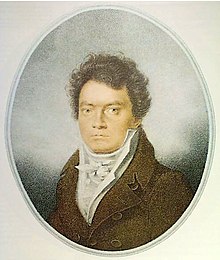Cello Sonata No. 5 (Beethoven)
The cello sonata No. 5 in D major op. 102,2 is a sonata for cello and piano by Ludwig van Beethoven .
Emergence
Beethoven wrote the cello sonatas op. 102 for his long-time patroness, Countess Anna-Maria Erdődy , and Joseph Linke , the cellist of the Schuppanzigh Quartet , with whom Beethoven was closely connected, especially through the performance of his string quartets. The two cello sonatas op. 102 were composed in the summer of 1815 and were premiered by Linke together with Beethoven's student Carl Czerny .
To the music
The sonata op. 102,2 is structured similarly to Beethoven's piano trio in D major, op 70,1 , the so-called “ghost trio”: A movement with an idiosyncratic main theme consisting of empty octaves is followed by a calm middle movement, while the sonata with one thoughtful finale in D minor is completed.
The sonatas op. 102 are among Beethoven's late works.
1st movement: Allegro con brio
The opening movement of the sonata, like its finale, is polyphonic. Beethoven varies here sonata form by the traditional in the implementation is settled issues processing until the recapitulation begins.
2nd movement: Adagio con molto sentimento d'affetto, attacca
The painful expression of the middle movement starts in the chorale , which consists of four lines of verse, and continues increasingly in the lyrical middle section in D major up to the recapitulation and coda . The melody of the coda has its roots in the middle section and points to the fugue theme of the finale and serves as a transition.
3rd movement: Allegro - Allegro fugato
A scale played by the cello and picked up by the piano marks the beginning of the third movement and thus resembles the beginning of the finale of Beethoven's 1st Symphony in C major, Op. 21 . The design of the final fugue of the Sonata op. 102,2 points to the Piano Sonata No. 29 in B flat major, Op. 106 ("Hammerklavier Sonata "), which was completed in 1818 . But already the implementation leaves the usual joint scheme , among other things through premature termination of the topic and further assignments in the narrow section , which Carl Dahlhaus described as "the mere appearance of a narrow section". Further deviations from the fugue scheme, such as the inversion in the pianissimo or the second counterpoint, are directed against the "relentlessness of the fugitive treatise" .
As an overall assessment of the fugue, Carl Dahlhaus wrote in 1978:
"The fugue [...] is not so much a representation of a firmly delineated theme in changing contrapuntal configurations, but rather the development of a substance that actually becomes actual in the thematic process to which the fugue shape was transformed."
effect
Both cello sonatas op. 102 are dedicated to Countess Anna-Maria Erdődy. The first print of the sonatas was published in 1817 by the Simrock publishing house in Bonn .
The contrapuntal character of both sonatas caused confusion. In 1824, Adolf Bernhard Marx wrote in the “ Allgemeine Musikalische Zeitung ” about the finale of the Sonata op. 102.2: “This is followed by an artificially crafted fugue of 6 pages, which Rec. At least admits originality” .
literature
supporting documents
- Booklet to the double CD Beethoven - Complete Cello Sonatas 1–5 ( Adrian and Alfred Brendel ). Philips (Universal), 2004.
- Harenberg cultural guide chamber music. 3rd, completely revised edition. Meyers Lexikonverlag, Mannheim 2008, ISBN 978-3-411-07093-0 .
- Jürgen Heidrich: violoncello sonatas. In: Sven Hiemke (Ed.): Beethoven-Handbuch. Bärenreiter-Verlag Karl Vötterle GmbH & Co. KG et al., Kassel et al. 2009, ISBN 978-3-7618-2020-9 , pp. 476-482.
further reading
- Carl Dahlhaus : "From two cultures of music". The final fugue from Beethoven's cello sonata Opus 102, 2. In: Die Musikforschung. Vol. 31, 1978, ISSN 0027-4801 , pp. 397-404.
- Hermann Danuser : Beethoven's Cello Sonatas opus 102. Some thoughts on form and interpretation analysis. In: Friedhelm Döhl (Ed.): Beethoven '77. Contributions to the Beethoven Week 1977. Organized by the Basel Music Academy. Amadeus, Zurich 1979, pp. 65-78.
Web links
- Cello Sonata No. 1 in D major, Op. 102,2 : Sheet music and audio files in the International Music Score Library Project
Individual evidence
- ↑ Carl Dahlhaus: "Of two cultures of music". The final fugue from Beethoven's cello sonata Opus 102, 2. In: Die Musikforschung. Vol. 31, 1978, pp. 397-404, here p. 398.
- ↑ Hermann Danuser: Beethoven's Cello Sonatas opus 102. Some thoughts on form and interpretation analysis. In: Friedhelm Döhl (Ed.): Beethoven '77. Contributions to the Beethoven Week 1977. Organized by the Basel Music Academy. Amadeus, Zurich 1979, pp. 65–78, here p. 76.
